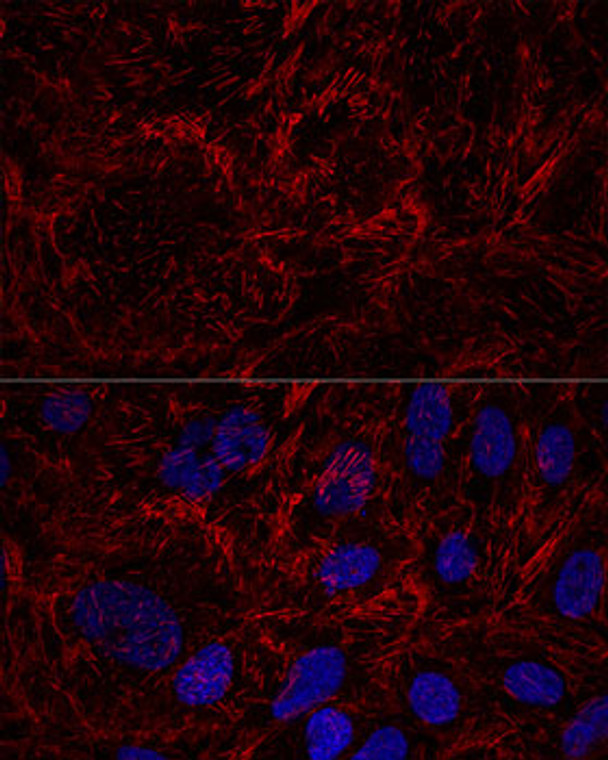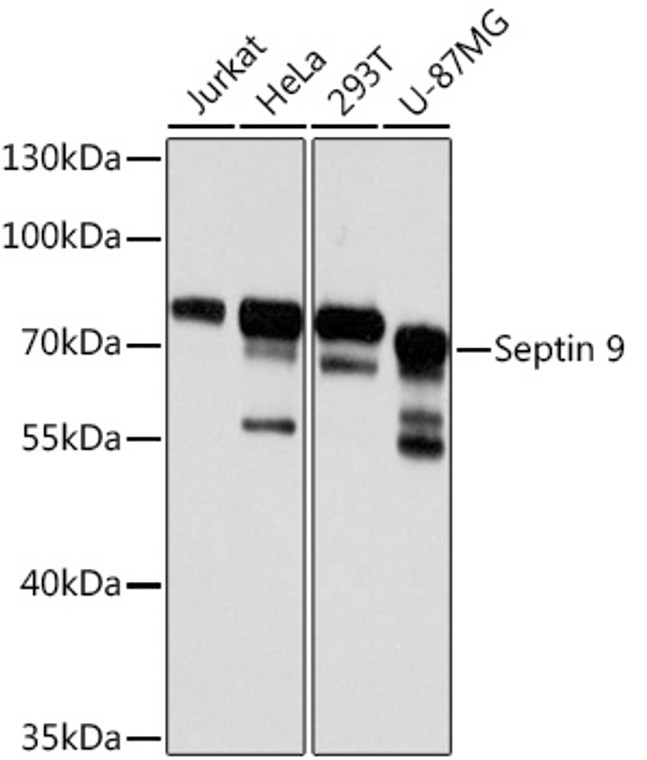| Host: |
Rabbit |
| Applications: |
WB/IF |
| Reactivity: |
Human/Mouse/Rat |
| Note: |
STRICTLY FOR FURTHER SCIENTIFIC RESEARCH USE ONLY (RUO). MUST NOT TO BE USED IN DIAGNOSTIC OR THERAPEUTIC APPLICATIONS. |
| Short Description: |
Rabbit polyclonal antibody anti-SEPT9 (1-110) is suitable for use in Western Blot and Immunofluorescence research applications. |
| Clonality: |
Polyclonal |
| Conjugation: |
Unconjugated |
| Isotype: |
IgG |
| Formulation: |
PBS with 0.02% Sodium Azide, 50% Glycerol, pH7.3. |
| Purification: |
Affinity purification |
| Dilution Range: |
WB 1:500-1:2000IF/ICC 1:50-1:200 |
| Storage Instruction: |
Store at-20°C for up to 1 year from the date of receipt, and avoid repeat freeze-thaw cycles. |
| Gene Symbol: |
SEPTIN9 |
| Gene ID: |
10801 |
| Uniprot ID: |
SEPT9_HUMAN |
| Immunogen Region: |
1-110 |
| Immunogen: |
Recombinant fusion protein containing a sequence corresponding to amino acids 1-110 of human Septin 9 (NP_001106964.1). |
| Immunogen Sequence: |
MEPPASKVPEVPTAPATDAA PKRVEIQMPKPAEAPTAPSP AQTLENSEPAPVSQLQSRLE PKPQPPVAEATPRSQEATEA APSCVGDMADTPRDAGLKQA PASRNEKAPV |
| Tissue Specificity | Widely expressed. Isoforms are differentially expressed in testes, kidney, liver heart, spleen, brain, peripheral blood leukocytes, skeletal muscle and kidney. Specific isoforms appear to demonstrate tissue specificity. Isoform 5 is the most highly expressed in fetal tissue. Isoform 1 is detected in all tissues except the brain and thymus, while isoform 2, isoform 3, and isoform 4 are detected at low levels in approximately half of the fetal tissues. |
| Function | Filament-forming cytoskeletal GTPase. May play a role in cytokinesis (Potential). May play a role in the internalization of 2 intracellular microbial pathogens, Listeria monocytogenes and Shigella flexneri. |
| Protein Name | Septin-9Mll Septin-Like Fusion Protein Msf-AMll Septin-Like Fusion ProteinOvarian/Breast SeptinOv/Br SeptinSeptin D1 |
| Cellular Localisation | CytoplasmCytoskeletonIn An Epithelial Cell LineConcentrates At Cell-Cell Contact AreasAfter Tgf-Beta1 Treatment And Induction Of Epithelial To Mesenchymal TransitionColocalizes Partly With Actin Stress FibersDuring Bacterial InfectionDisplays A Collar Shape Structure Next To Actin At The Pole Of Invading Bacteria |
| Alternative Antibody Names | Anti-Septin-9 antibodyAnti-Mll Septin-Like Fusion Protein Msf-A antibodyAnti-Mll Septin-Like Fusion Protein antibodyAnti-Ovarian/Breast Septin antibodyAnti-Ov/Br Septin antibodyAnti-Septin D1 antibodyAnti-SEPTIN9 antibodyAnti-KIAA0991 antibodyAnti-MSF antibodyAnti-SEPT9 antibody |
Information sourced from Uniprot.org
12 months for antibodies. 6 months for ELISA Kits. Please see website T&Cs for further guidance










